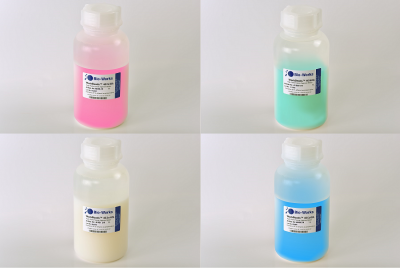WorkBeads 40 Ni-IDA
페이지 정보
본문
카다로그 번호 : 40-650-001 / 40-650-003 / 40-650-010
규격 : 25ml / 150ml / 1000ml
브랜드 : Bio-works
비고 :
상세설명
Immobilized metal-ion affinity chromatography (IMAC) resin
The WorkBeads resins are based on nitrilotriacetic acid (NTA) and the iminodiacetic acid (IDA) chelating groups. The resins can easily be charged before use with a broad spectrum of divalent or trivalent transition metal ions, including Ni2+, Co2+, Cu2+, Zn2+, Ga3+ or Fe3+. They can then be used for IMAC purification of His-tagged proteins or other proteins with an affinity for metal ions. The selectivity of the metal charged resin depends on both the choice of ligand (NTA or IDA) and the metal ion used. These resins can also be used for divalent metal ion removal.
- Resin can be charged (or be pre-charged) with the metal ion of choice
- High binding capacity and purity. Outstanding flow properties.
- Reliable and reproducible results
WorkBeads™ 40 IDA resins are based on the iminodiacetic acid (IDA) chelating groups. The resins can easily be charged, before use, with a broad spectrum of divalent or trivalent transition metal ions, including Ni2+, Co2+, Cu2+ and Zn2+, Ga3+ or Fe3+. They can then be used for the Immobilized Metal Ion Affinity Chromatography (IMAC) purification of His-tagged proteins or other proteins with an affinity for metal ions. , which are immobilized via a metal chelating ligand on the chromatography resin.
.- Resin charged (or pre-charged) with the metal ion of choice
- High binding capacity and purity. Outstanding flow properties.
- Reliable and reproducible results
- Prepacked ready-to-use columns for rapid and reliable results - see BabyBio IMAC page
Product
The WorkBeads™ IDA resins are based on the iminodiacetic acid (IDA) chelating group. The resin can easily be charged, before use,with a broad spectrum of divalent or trivalent transition metal ions, including Ni2+, Co2+, Cu2+ or Zn2+, Fe3+ or Ga3+.
They can then be used for the Immobilized Metal Ion Affinity Chromatography (IMAC) purification of His-tagged proteins or other proteins with an affinity for metal ions. The selectivity of the metal-charged resin depends on both the choice of ligand (NTA or IDA) and the metal ion used. The uncharged resins can also be used for divalent metal ion removal..





